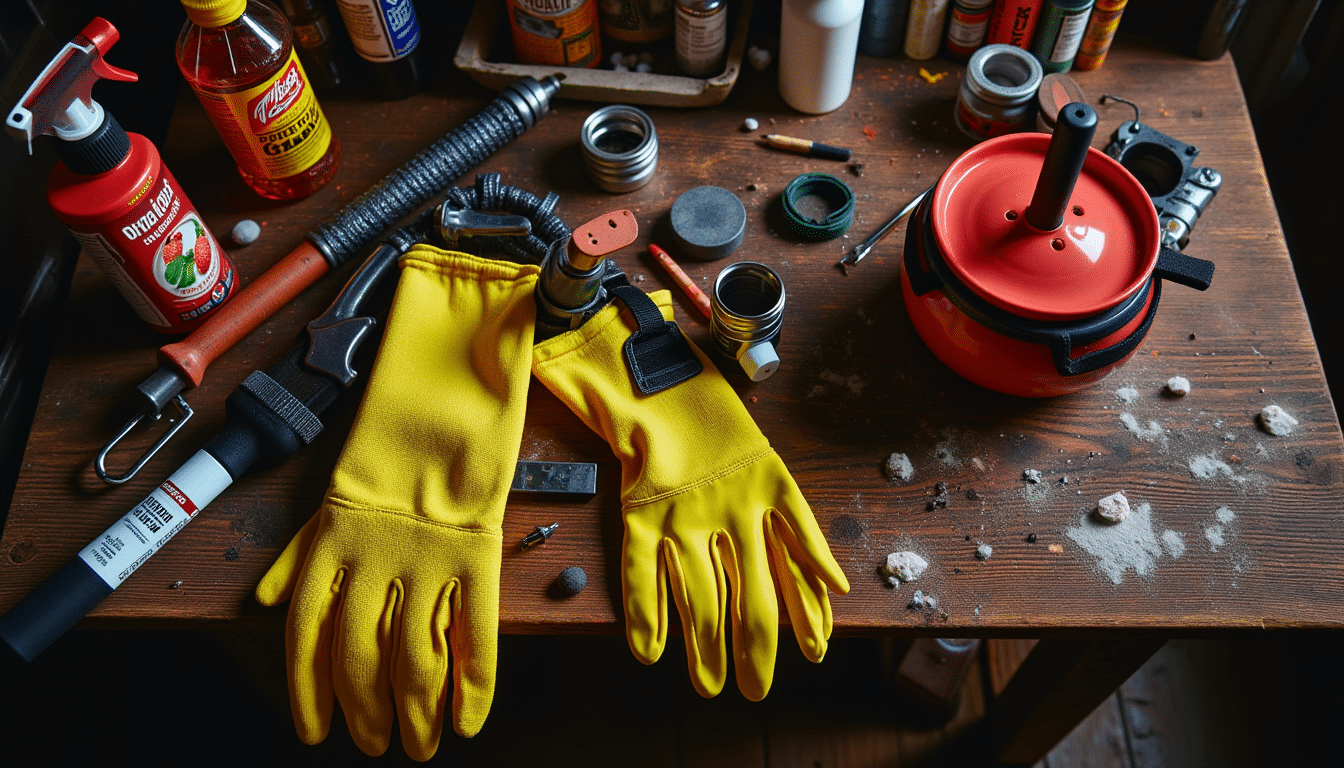Why Do Drains Block in the First Place?
Understanding what causes blocked drains can help prevent future issues. In my experience renovating properties across Lancashire, these are the most common culprits:
- Hair and soap scum: Particularly problematic in bathroom drains
- Food waste and cooking oils: Kitchen sink enemies number one and two
- Foreign objects: From children’s toys to cotton buds and wet wipes
- Tree roots: More common in older properties with mature gardens
- Mineral build-up: Especially in hard water areas
- Leaves and debris: Outdoor drain blockages peak during autumn months
The good news is that many blockages can be cleared without professional help. Let’s look at how.

Essential Tools for DIY Drain Unblocking
Before we dive into techniques, having the right tools ready will make your drain unblocking efforts much more successful:
- Rubber gloves
- Plunger (ideally a flat-bottomed sink plunger)
- Drain snake or auger
- Bucket
- Old towels
- Bicarbonate of soda and white vinegar
- Kettle for boiling water
- Commercial drain cleaner (as a last resort)
I always recommend starting with the simplest methods before progressing to more involved solutions.
Method 1: The Hot Water Flush
This basic technique is surprisingly effective, particularly for minor grease blockages in kitchen sinks.
What you’ll need:
- Kettle
- Washing-up liquid
Steps:
- Boil a full kettle of water
- Pour a small amount of washing-up liquid directly down the drain
- Carefully pour the boiling water down the drain in two or three stages, allowing each pour to work for a few minutes
This method works by melting fatty deposits that may be causing the blockage. For bathroom sinks, use hot but not boiling water to avoid damaging PVC pipes.

Method 2: Plunger Power
The humble plunger remains one of the most effective tools for clearing blockages, especially in sinks and showers.
What you’ll need:
- Sink plunger
- Petroleum jelly
- Old towels
Steps:
- If you’re working on a sink with an overflow, cover it with a damp cloth
- Apply a thin layer of petroleum jelly around the rim of the plunger to create a better seal
- Fill the sink with enough water to cover the plunger’s rubber cup
- Place the plunger over the drain and pump vigorously 5-6 times
- Pull the plunger away sharply to create suction
- Repeat if necessary
For stubborn blockages, alternate between plunging and running hot water to help break down the obstruction.
Method 3: The Bicarbonate of Soda and Vinegar Method
This chemical reaction can be highly effective for breaking down organic matter and soap scum without harsh chemicals.
What you’ll need:
- 100g bicarbonate of soda
- 100ml white vinegar
- Kettle of boiling water
Steps:
- Pour the bicarbonate of soda directly down the drain
- Follow immediately with the vinegar
- The mixture will fizz vigorously – this is breaking down the blockage
- Cover the drain if possible and leave for 30 minutes
- Flush with boiling water
I’ve found this method particularly effective for bathroom sinks and showers where hair and soap are the primary culprits.

Method 4: Manual Removal
Sometimes, especially with shower drains, the blockage is visible and accessible enough for manual removal.
What you’ll need:
- Screwdriver to remove drain cover
- Rubber gloves
- Old wire coat hanger or drain snake
- Torch
Steps:
- Remove the drain cover (usually requires unscrewing)
- Using your gloved hand or tools, remove any visible debris
- For deeper blockages, straighten a wire coat hanger leaving a small hook at one end
- Feed the wire down the drain and twist to catch hair and debris
- For more serious blockages, use a proper drain snake, feeding it into the pipe and turning the handle when you meet resistance
- Flush with hot water after clearing
Working on heritage properties in Lancashire has taught me that older plumbing systems often benefit from this gentle mechanical approach rather than harsh chemicals.
Method 5: Commercial Drain Cleaners
When other methods fail, chemical drain cleaners can be effective, though they should be used with caution.
What you’ll need:
- Chemical drain cleaner
- Rubber gloves
- Eye protection
Steps:
- Read and follow the manufacturer’s instructions precisely
- Ensure the room is well-ventilated
- Pour the recommended amount down the drain
- Allow it to work for the specified time
- Flush thoroughly with water
Important safety note: Never mix different chemical cleaners as this can create dangerous gases. Also, some older pipes may be damaged by harsh chemicals, so consider the age and material of your plumbing before using this method.
Unblocking Outdoor Drains
External drainage issues require slightly different approaches:
What you’ll need:
- Drain rod set
- Protective gloves
- Hose with high-pressure attachment
- Bucket and old towels
Steps:
- Locate your drain access point and remove the cover (use a screwdriver or drain key)
- Check for and remove any obvious debris using gloved hands
- For deeper blockages, connect drain rods and push them into the drain
- Rotate the rods clockwise (turning anti-clockwise can cause the rods to unscrew and get lost in the drain)
- Once you feel the blockage clear, flush with a hosepipe to ensure water flows freely
Living in Lancashire, where autumn leaves frequently cause outdoor drain blockages, I recommend checking external drains regularly during the fall season to prevent major issues.

When to Call a Professional
While DIY methods can resolve many blockages, some situations warrant professional attention:
- Multiple fixtures are affected (suggesting a main line blockage)
- Recurring blockages despite your best efforts
- Sewage backing up into fixtures
- Unusual sounds or smells from pipes
- Water damage appearing on walls or ceilings
- Very old properties where plumbing may be fragile
Professional drain unblocking services typically cost between £75-£150 in the UK for standard blockages, though complex issues may cost more. While not inexpensive, professional help can prevent costly damage from persistent problems.
Preventing Future Drain Blockages
An ounce of prevention is worth a pound of cure, especially when it comes to drain maintenance:
- In the kitchen: Use sink strainers to catch food particles, and never pour fats or oils down the drain (collect and dispose of them separately)
- In the bathroom: Install hair catchers in showers and baths, and regularly clean them
- For all drains: Run hot water down drains after each use to prevent build-up
- Monthly maintenance: Pour a cup of bicarbonate of soda followed by a cup of vinegar down drains, leave for 30 minutes, then flush with hot water
- Outdoor drains: Clear leaves and debris regularly, especially in autumn
For more comprehensive home maintenance advice, check out our seasonal home maintenance checklist to keep your property in top condition year-round.
Final Thoughts
In my decades of working with heritage properties across Lancashire, I’ve found that most drain blockages can be resolved with patience and the right approach. While modern homes may have more resilient plumbing systems than the Victorian terraces I often work with, the principles of drain maintenance remain largely unchanged.
Remember that regular maintenance is far easier than dealing with major blockages. A simple monthly flush with hot water and bicarbonate of soda can save you significant hassle down the line.
And finally, if you’re unsure about tackling a blockage yourself, particularly in older properties where plumbing may be more delicate, there’s no shame in calling in a professional. The Water Research Centre provides excellent guidance on maintaining healthy drainage systems if you’re looking to deepen your understanding of home plumbing.
Have you successfully tackled a stubborn drain blockage? Share your experiences in the comments below – I’m always keen to learn new techniques from fellow home maintenance enthusiasts.






